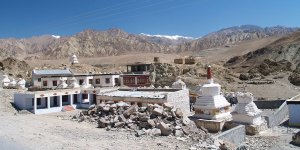| Travel / Ashram, Monasteries |
Diskit Monastery, Ladakh, India
Gelug Tradition, 14th century, about 100 monks.
Diskit Monastery also known as Deskit Gompa or Diskit Gompa is the oldest and largest Buddhist monastery (gompa) in the Nubra Valley of Ladakh, northern India. It belongs to the Gelugpa (Yellow Hat) sect of Tibetan Buddhism and it is a branch of Thiksay monastery.

Diskit Monastery. Photo: John Hill, Wikipedia
Location
The Diskit monastery is situated on the hill above the flood plains of the Shyok River, on its right bank in the Diskit village (3,144 meters) in Nubra Valley.
Since the valley is at lower elevation, it has a mild climate. This climatic condition has created lush vegetation which gave it the name of "Orchard of Ladakh".
History
The Diskit monastery was founded by Jangsem Sherab Zangpo, a disciple of Tsongkhapa1, in the 14th century. A local ruler named Nyig-ma-grags-pa assisted in building the monastery at Diskit and deify Tsongkhapa in the monastery.
During the rule of King Blogros-chog-idan (1440–1470) who had even controlled western Tibet, Panchen Lha-btsun - a resident of Nubra Valley by birth - studied in Tibet and later became a regent to the founder of Tashilhunpo Monastery and finally during his last stage of life returned to Nubra. His remains have been preserved in Charasa village.
In 1500, Ladakh was ruled by Bkra-shis-rnam-rgyal, who fought the invader Mirza Haider of Central Asia, in Nubra and close to Leh, finally defeated the latter and thus bringing Nubra under Ladakh King’s rule. Even then, the local chieftains still yielded power in Diskit and Hundar.
Shia Muslims started settling in Nubra after this war. Bkra-shis-rnam-rgyal’ son, Tshedbang-rnam-rgyal ruled Ladakh from 1530 and expanded his kingdom.
At that time, Nubra people prevailed on him and preventing him from invading Hor in Xinjiang, as trade with Yarkand was considered crucial to Nubra.
During the reign of Jams-dbang-rnam-rgyal, historical records indicate that a regular tribute payment was made by the Nubra people to the king. The King Bde-‘Idanrnam-rgyal (1620–45) successfully defeated Baltistan and the Mughals. Rgyal kings were very religious and built mani walls2 throughout their kingdom.
Monks were specially engaged to recite hymns in Nubra Valley and in other surrounding areas.
In mid eighteenth century, Tshedbang-rnam-rgyal gave away the control of Diskit monastery to the Rinpoche of Thikse Monastery and this arrangement has been perpetuated to this day. Since then, Diskit is considered a sub-gompa of Thiksay.
Features
The monastery has statue of Cho Rinpoche (Crowned Buddha) in the prayer hall, and several images of fierce guardian deities. A statue of Maitreya Buddha is enshrined in the hall.

A renovated mural depicting the Four Heavenly Kings. Photo: Redtiger, Wikipedia.
Diskit Monastery has an elevated cupola, with a fresco depicting the Tashilhunpo Monastery of Tibet. It also has several shrines and Mongolian and Tibetan texts in the storehouse.
Above the monastery stands the Lachung Temple, famous for the large statue of Tsongkhapa. It is believed to be one of the oldest temples in the Nubra Valley.

32 meter statue of Maitreya Buddha near Diskit Monastery facing down the Shyok River. Photo: John Hill, Wikipedia.The monastery administration runs a school, with support from a non-government organization known as the "Tibet Support Group", which has computer facilities and teaches science subjects in English, to Tibetan children of the region.
Recent extensions to the monastery building are in good condition but the Dukhang ("main prayer hall") and other parts are not so.
Paintings have been covered with soot and images are kept in total disorder.
The older part of the monastery is said to be in certain degree of decay, as cracks have been observed, and they remain untended.
Festivals
A popular festival known as Dosmoche or the "Festival of the Scapegoat" is held in the precincts of the monastery in February during the winter season, which is largely attended by people from villages of the Nubra Valley since the other regions in Leh are inaccessible during this period due to heavy snow fall.
The highlight of the festival is the Cham Dance performed by the Lamas of the monastery.3
Travel and Visiting
The best time to visit Diskit Monastery is May to September, as the weather is pleasant and the roads are accessible.
The Monastery is open to visitors from 7:00 AM to 7:00 PM, except for a break between 1:00PM and 2:00PM.
Diskit Monastery can be reached is by road, from the Manali-Leh highway via Manali or Srinagar.
Sources
https://en.wikipedia.org/wiki/Diskit_Monastery
https://treasuryoflives.org/biographies/view/Sherap-Zangpo/TBRC_P483
Footnotes
1. At age 17 he went to Ganden Monastery where he was accepted as a student by Tsongkhapa, the founder of the Gelugpa sect. He studied Vinaya, Prajñāpāramitā, Madhyamika, Pramāṇavārttika and Abhidharmakośa. Later, he was a tutor of the First Dalai Lama, Gendun Drub. Sherab Zangpo is considered by the tradition to have been one of "six great banners," or six disciples of Tsongkhapa deemed especially qualified for disseminating the teachings of the Gelug tradition to the outer regions of Tibet.
2. Mani stones or walls are stone plates, rocks, carved or inscribed with the six syllabled mantra of Avalokiteśvara (Auṃ maṇi padme hūṃ, hence the name "Mani stone"), as a form of prayer in Tibetan Buddhism.
3. The cham dance is a lively masked and costumed dance associated with some sects of Tibetan Buddhism and Buddhist festivals. The dance is accompanied by music played by monks using traditional Tibetan musical instruments. The dances often offer moral instruction relating to karuṇā (compassion) for sentient beings and are held to bring merit to all who perceive them.
Chams are considered a form of meditation and an offering to the gods. The leader of the cham is typically a musician, keeping time using some percussion instrument. Chams often depict events from the life of Padmasambhava, the 9th century Nyingmapa teacher, and other saints.
YOU MAY ALSO LIKE





